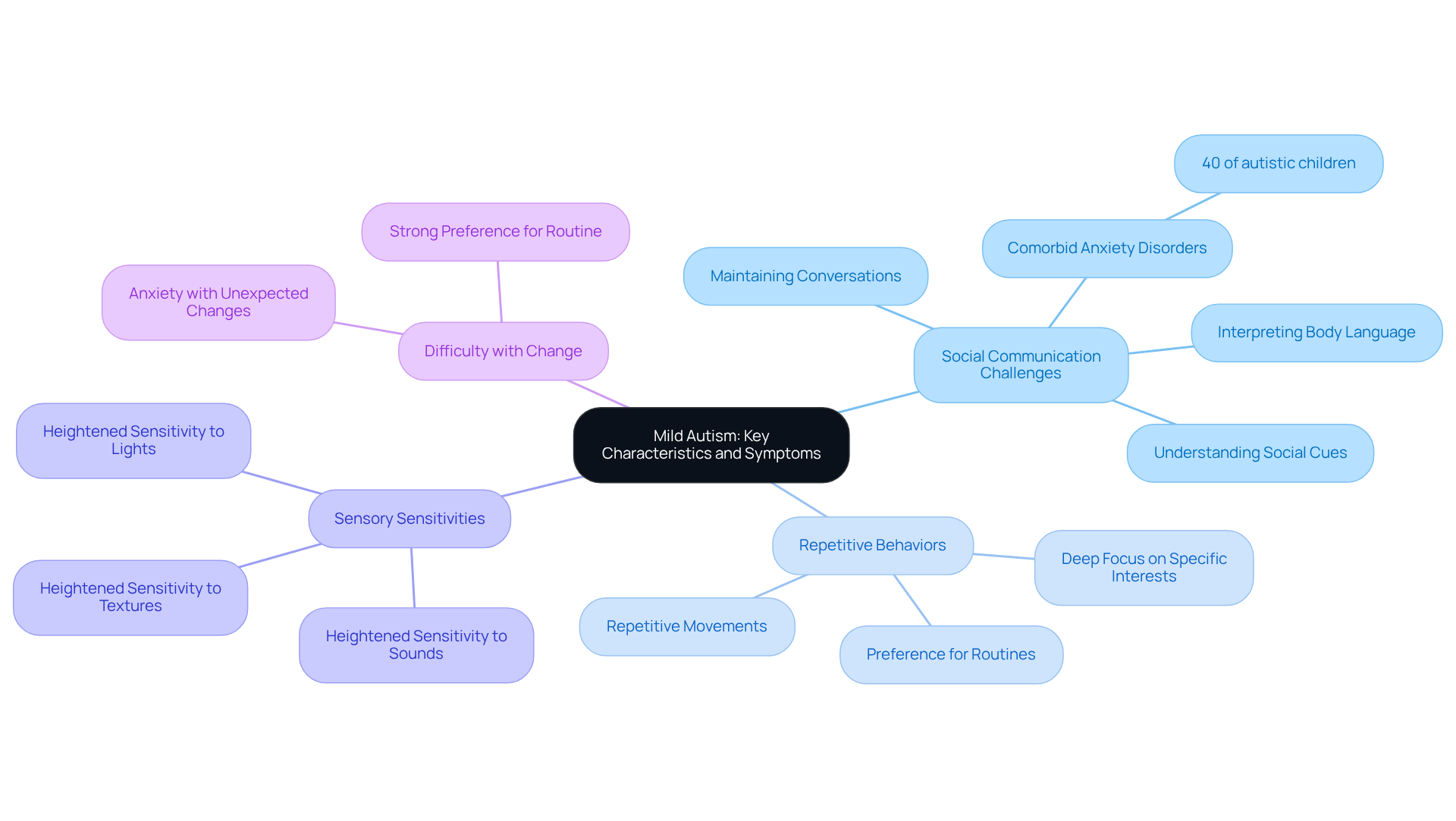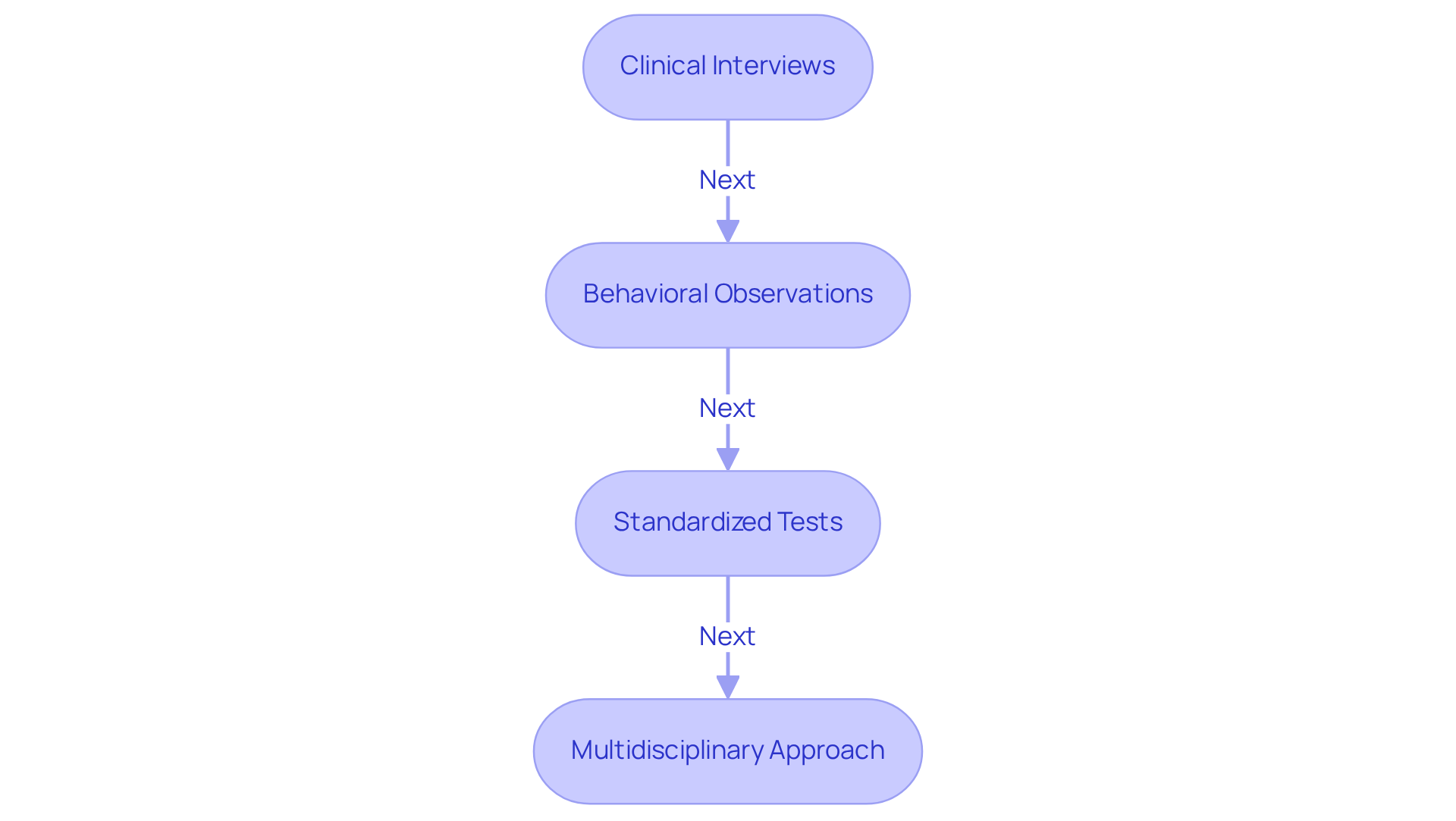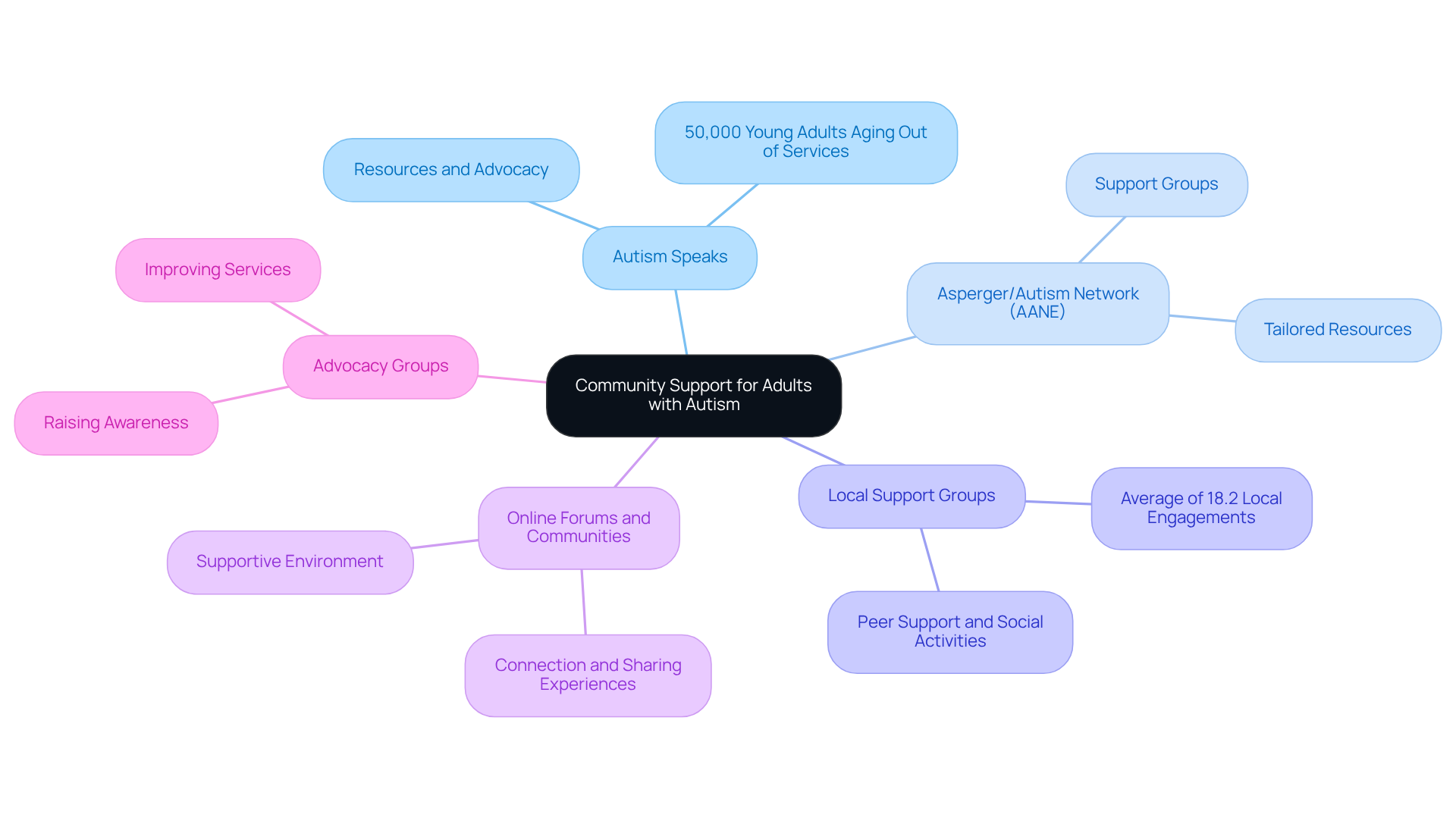Overview
This article shines a light on the various treatment options and support available for adults with mild autism, offering a compassionate overview of therapies like Cognitive Behavioral Therapy (CBT) and Applied Behavior Analysis (ABA). It also highlights community resources such as Autism Speaks and the Asperger/Autism Network, which play a crucial role in this journey.
Understanding the unique needs of individuals with mild autism is essential, and a comprehensive approach that combines these therapies with community engagement can significantly enhance their quality of life. By embracing this holistic perspective, we can better support those navigating the challenges of autism.
We invite you to explore these resources and consider how they might make a difference in your or your loved one's life. Sharing experiences and insights can foster a supportive community, so feel free to engage in the comments or reach out through newsletters. Together, we can create a nurturing environment that uplifts and empowers individuals with mild autism.
Introduction
Understanding mild autism in adults is essential, as it encompasses a range of characteristics and challenges that can profoundly affect daily life. This article explores various treatment options and support systems available, underscoring the significance of personalized approaches that meet individual needs.
With so many therapies and resources at their disposal, families may wonder: how can they navigate this intricate landscape to secure the best outcomes for their loved ones?
Your journey towards understanding and support begins here.
Define Mild Autism: Key Characteristics and Symptoms
The mild form of this condition, often referred to as the high-functioning type, presents a variety of characteristics that can differ greatly among individuals. Key symptoms include:
- Social Communication Challenges: Many individuals face difficulties in understanding social cues, maintaining conversations, or interpreting body language. It's important to recognize that nearly 40% of autistic children and adolescents also experience at least one comorbid anxiety disorder, which can intensify these challenges.
- Repetitive Behaviors: This may show up as a preference for routines, repetitive movements, or a deep focus on specific interests.
- Sensory Sensitivities: Numerous adults with mild developmental disorders report heightened sensitivity to sensory inputs like sounds, lights, or textures.
- Difficulty with Change: A strong preference for routine can lead to anxiety when confronted with unexpected changes.
Recognizing these symptoms is the first step in understanding and supporting individuals with mild developmental differences. It's crucial to note that this spectrum condition affects 1 in 36 children, underscoring the importance of grasping its characteristics and symptoms. Moreover, families often face significant financial burdens, with the average cost of supporting a person with developmental disorders reaching $60,000 annually. As Dena Gassner poignantly stated, "You don’t outgrow this condition. You grow into it," which highlights the lifelong nature of these challenges. By fostering understanding and support, we can make a meaningful difference in the lives of those affected.

Diagnose Mild Autism: Assessment Criteria and Processes
Diagnosing mild autism is a journey that requires a thorough assessment process, encompassing several key components that are vital for understanding your child's unique needs.
- Clinical Interviews are often the first step. Healthcare professionals conduct in-depth conversations with both the individual and their family, gathering detailed developmental histories. This information is crucial for painting a complete picture of your child's background and experiences.
- Next, Behavioral Observations play a significant role. By monitoring your child in various settings, experts can evaluate their interactions and communication abilities. This approach offers valuable insights into their behavior in real-life situations, helping you understand their world better.
- Standardized Tests are also essential. Instruments like the Autism Diagnostic Observation Schedule (ADOS) and the Autism Diagnostic Interview-Revised (ADI-R) help evaluate symptoms against established diagnostic criteria. According to the American Psychiatric Association, "to meet diagnostic criteria for ASD according to DSM-5, a child must have persistent deficits in each of three areas of communication and interaction plus at least two of four types of restricted, repetitive behaviors." These tests ensure consistency and reliability in the assessment process.
- A Multidisciplinary Approach is key to a holistic evaluation. Collaboration among specialists—including psychologists, speech therapists, neurodevelopmental pediatricians, and developmental-behavioral pediatricians—ensures that all aspects of your child's behavior and development are addressed.
This comprehensive approach guarantees that every relevant aspect is considered, leading to a more accurate diagnosis and better-informed treatment options. It's important to recognize that Autism Spectrum Disorder (ASD) is prevalent, affecting approximately 1 in 31 children. Often, it co-occurs with conditions such as ADHD and anxiety, which can complicate the diagnostic process.
If you find yourself navigating this path, know that you are not alone. Reach out for support and resources that can help you and your child thrive.

Explore Treatment Options: Therapies and Support for Adults
When it comes to treatment for mild autism in adults, there is a wide array of options that can truly make a difference in their lives. Understanding these options is crucial for families seeking the best support for their loved ones. Effective strategies often include:
- Cognitive Behavioral Therapy (CBT): This nurturing approach helps individuals manage anxiety and develop valuable coping strategies for social situations.
- Applied Behavior Analysis (ABA): As a treatment for mild autism in adults, ABA focuses on reinforcing positive behaviors while working to reduce challenging ones through structured interventions, fostering growth and confidence.
- Social Skills Training: Programs designed to enhance social interactions and communication skills can significantly benefit individuals, particularly as a treatment for mild autism in adults, making social engagements less daunting.
- Occupational Therapy: This treatment for mild autism in adults aids in developing daily living skills and managing sensory sensitivities, ensuring a more comfortable daily experience.
- Medication Management: In some instances, medications may be prescribed as a treatment for mild autism in adults to address co-occurring conditions such as anxiety or depression, providing additional support.
Combining these therapies can lead to a customized treatment for mild autism in adults that addresses the unique needs of each individual. By exploring these options, families can find the right treatment for mild autism in adults, which fosters growth and connection in their loved ones' lives.

Engage with Community Support: Advocacy and Resources
Participating in local assistance is essential for adults in need of treatment for mild autism in adults. It’s important to recognize the resources and advocacy groups that can profoundly impact their lives:
- Autism Speaks: This organization provides a wealth of information on resources, advocacy initiatives, and community events aimed at enhancing the lives of individuals with autism. Alarmingly, Autism Speaks reports that 50,000 young adults with autism age out of school-based services each year, losing access to critical resources.
- Asperger/Autism Network (AANE): AANE is dedicated to offering support groups and tailored resources specifically designed for adults on the spectrum, fostering a sense of belonging and understanding. Their programs have shown to enhance community involvement among participants, which is vital for personal growth and can serve as a treatment for mild autism in adults.
- Local Support Groups: Many neighborhoods host local organizations that facilitate peer support and social activities, creating valuable opportunities for connection and engagement. Research indicates that participants engage in local activities an average of 18.2 times over the previous 30-day period, underscoring the importance of these networks.
- Online Forums and Communities: Platforms like Reddit and specialized forums provide spaces for individuals to connect, share experiences, and seek advice in a supportive environment. These online communities can be lifelines for those who may feel isolated in their local surroundings.
- Advocacy Groups: Various organizations are committed to supporting individuals with developmental disorders, working diligently to raise awareness and improve services. As Megan Hull poignantly stated, "Insufficient assistance for adults with developmental disorders leads individuals to experience failure, poverty, and diminished quality of life," emphasizing the necessity of robust local resources.
By connecting with these resources, individuals can find vital support for the treatment for mild autism in adults, share their experiences, and effectively advocate for their needs, ultimately enhancing their quality of life. Additionally, ASD Media plays a crucial role in providing resources and support for parents and professionals in the field, further empowering the autism community. Together, we can create a network of understanding and support that uplifts everyone involved.

Conclusion
Understanding and addressing the complexities of mild autism in adults is vital for fostering a supportive environment that promotes well-being and personal growth. Recognizing the unique characteristics and symptoms associated with mild autism is essential, as early identification and comprehensive support can profoundly impact individuals and their families.
Key insights discussed include:
- The critical assessment processes necessary for accurate diagnosis
- The range of effective treatment options available
- The importance of community engagement
Therapeutic strategies such as Cognitive Behavioral Therapy, Applied Behavior Analysis, and occupational therapy can be tailored to meet individual needs. Advocacy groups and local resources provide essential support systems that enhance quality of life.
Ultimately, fostering a network of understanding and support is essential for empowering adults with mild autism. By actively engaging with available resources and advocating for comprehensive treatment options, communities can create an inclusive environment that uplifts individuals on the spectrum. This collective effort not only aids those directly affected but also enriches society as a whole, highlighting the importance of compassion, awareness, and connection in addressing the challenges of mild autism.
Frequently Asked Questions
What is mild autism often referred to as?
Mild autism is often referred to as the high-functioning type.
What are some key characteristics of mild autism?
Key characteristics include social communication challenges, repetitive behaviors, sensory sensitivities, and difficulty with change.
What social communication challenges do individuals with mild autism face?
Individuals may have difficulties understanding social cues, maintaining conversations, or interpreting body language.
How common are comorbid anxiety disorders in autistic children and adolescents?
Nearly 40% of autistic children and adolescents experience at least one comorbid anxiety disorder.
What are examples of repetitive behaviors in individuals with mild autism?
Repetitive behaviors may include a preference for routines, repetitive movements, or an intense focus on specific interests.
What sensory sensitivities do adults with mild developmental disorders report?
Adults often report heightened sensitivity to sensory inputs such as sounds, lights, or textures.
How does a preference for routine affect individuals with mild autism?
A strong preference for routine can lead to anxiety when they are confronted with unexpected changes.
How prevalent is autism spectrum condition among children?
Autism spectrum condition affects 1 in 36 children.
What is the average annual cost of supporting a person with developmental disorders?
The average cost of supporting a person with developmental disorders reaches $60,000 annually.
What does the quote by Dena Gassner about autism imply?
The quote highlights that individuals do not outgrow autism but rather grow into it, emphasizing the lifelong nature of the challenges associated with the condition.




